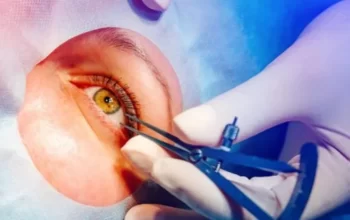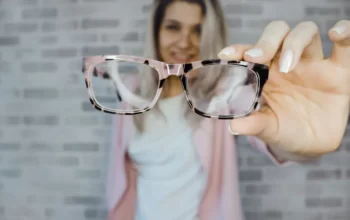
The optic nerve, which serves as the main conduit for information between the eye and the brain, is harmed by the eye condition glaucoma. It is brought on by an abundance of aqueous humor, a type of fluid, in the front of the eye, which raises the pressure there.
Glaucoma is actually the main factor in vision loss or blindness in people over 60. Glaucoma cannot be cured, but if caught early enough, it can be treated. Because of this, it’s crucial that everyone is aware of the early glaucoma symptoms and warning signs.
The initial glaucoma symptoms and signs are described in this article. Please keep reading if you’re interested.
What Is Glaucoma?
The optic nerve in your eye is harmed by glaucoma. With time, it becomes worse. It frequently has to do with an increase in pressure inside your eye. Glaucoma frequently runs in families. It typically doesn’t occur until much later in life.
The optic nerve, which transmits images to your brain, can be harmed by increased intraocular pressure in your eye. Glaucoma can within a few years result in total blindness or permanent vision loss if the damage worsens.
Most glaucoma sufferers don’t experience any pain or early symptoms. Visit your eye doctor frequently so they can detect and treat glaucoma early on before you lose your vision permanently.
It is impossible to regain lost vision. However, lowering eye pressure can help you preserve your current level of vision. Most glaucoma patients who adhere to their treatment schedule and receive regular eye exams are able to preserve their vision.
The Causes Of Glaucoma
Aqueous humor, the liquid that fills your eye, usually exits through a channel that resembles a mesh. The liquid can build up if this channel becomes blocked or the eye is producing too much fluid. Experts occasionally are unsure of what causes this obstruction. However, it is heritable, which means that it is transmitted from parents to offspring.
The less common causes of glaucoma include inflammation, blunt or chemical eye trauma, severe eye infections, blocked blood vessels inside the eye, and blunt or chemical eye trauma. Rarely, but occasionally, it can be triggered by eye surgery to treat another condition. Usually, both eyes are affected, but sometimes one eye may be more severely affected.
What Is The First Sign Of Glaucoma?
Vision loss, usually to your peripheral vision, also referred to as side vision or tunnel vision, is frequently the first sign of glaucoma. You should make an appointment with your eye doctor as soon as you start to notice vision impairment at the edges of your visual field.
Although losing your vision is one of the early signs of glaucoma, it usually indicates the disease has advanced and is, therefore, more challenging to treat. In fact, most glaucoma patients won’t exhibit any early warning symptoms at all until it’s too late.
Particularly with open-angle glaucoma, the most prevalent form, this is true. Because of this, it’s critical to have routine eye exams with your eye doctor to spot this disease early on. They have the tools required to recognize, identify, and handle glaucoma in its early stages.
The Risk Factors Of Glaucoma
Eyes shut tightly should be screened for glaucoma during routine eye exams. Adulthood, especially older adulthood, should be the starting point for these eye exams.
Pupil dilating and IOP readings are part of a test to measure the pressure inside your eye as well as a glaucoma screening.
For glaucoma, there are some risk factors. The following can increase your odds of developing glaucoma:
- Genetics. Since it affects a family, this illness is thought to be hereditary. You have a four to nine times higher risk of developing glaucoma if someone in your immediate family has the condition.
- Age. Adults over 60 are the age group where glaucoma is most common.
- Race: People of African descent, Asian descent, Hispanic descent, and African Americans are all at higher risk for developing glaucoma, even as early as age 40.
- Long-term use of some medications, such as corticosteroids, increases the risk of glaucoma.
- Diabetes, extreme myopia, thin corneas, and hypertension are among the biological and medical factors that can raise the pressure inside your eye and increase your risk of developing glaucoma. Other biological factors include corneal thickness, persistent eye inflammation, and specific illnesses.

How Do I know If I Have Glaucoma?
Exams are quick and painless. A device known as a tonometer will be used by your eye doctor to measure the pressure in your eyes. You will be given eye drops to numb your eye so you won’t feel anything. Inform them if you’ve undergone refractive surgery, such as LASIK. The reading of your eye pressure may be impacted.
Eye pressure that is higher than usual is not necessarily a sign of glaucoma. In actuality, some people with normal blood pressure may have it while others with higher levels may not. Ocular hypertension is high pressure that does not harm the optic nerve. Your doctor will frequently want to test your eyes if you have this.
Your eye doctor will examine your optic nerve for indications of damage if they believe you have glaucoma. You’ll be required to take a test to determine how well you can see in the side or peripherally (they’ll call it that). OCT images of the nerve that makes up the optic nerve can provide information about the presence of glaucoma.
The ophthalmologist will identify congenital glaucoma in your child. A cloudy cornea is the main symptom. For this, newborns are examined. Contact an eye doctor if you believe you have an eye issue.
What Is the Treatment for Glaucoma?
To avoid vision loss, glaucoma treatment should start right away. Treatment may include:
- Prescription eye drops
- Prostaglandins: latanoprost (Xalatan), travoprost (Travatan Z), tafluprost (Zioptan), and bimatoprost (Lumigan)
- Rho kinase inhibitor: netarsudil (Rhopressa)
- Nitric oxides: latanoprostene bunod (Vyzulta)
- Miotic or cholinergic agents: pilocarpine (Isopto Carpine)
- Alpha-adrenergic agonists: apraclonidine (Iopidine) and brimonidine (Alphagan P, Qoliana)
- Beta blockers: timolol (Betimol, Istalol, Timoptic) and betaxolol (Betoptic)
- Carbonic anhydrase inhibitors: dorzolamide (Trusopt) and brinzolamide (Azopt)
- Laser trabeculoplasty
The Prevention Of Glaucoma
You can prevent vision loss or slow the progression of glaucoma by using these self-care techniques to identify the disease early.
Regular dilated eye exams. Thorough eye exams can aid in identifying glaucoma in its early stages before serious damage takes place. The American Academy of Ophthalmology advises having a comprehensive eye exam every five to ten years if you’re under 40; every two to four years if you’re 40 to 54; every one to three years if you’re 55 to 64; and every one to two years if you’re over 65. You will require more frequent screening if you are at glaucoma risk. Ask your doctor to suggest the best screening schedule for you.
Understand the history of eye disease in your family. A family history of glaucoma is common. You may require more frequent screening if you are at higher risk.
Regular and moderate exercise can lower eye pressure and help prevent glaucoma. Consult your doctor about a suitable exercise regimen.
Use eyedrops as directed on a regular basis. Glaucoma eyedrops can significantly lower the likelihood that high eye pressure will develop into glaucoma. Even if you are symptom-free, you must consistently use the eyedrops your doctor prescribed for the best results.
Serious eye injuries can cause glaucoma, so protect your eyes by wearing sunglasses. When working with power tools or playing high-speed racket sports in confined spaces, wear eye protection.
Conclusion
A progressive eye condition is a glaucoma. The damage is irreversible once you begin losing your vision. Future vision loss, however, can be slowed down or prevented. Keeping your IOP under control can help you avoid becoming blind. Most glaucoma sufferers can avoid going blind if they receive the right care. While it can be challenging to recognize glaucoma’s early warning signs on your own, routine visits to an eye care professional can help you catch the condition early.



